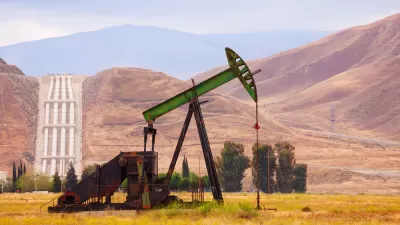Over a long career in public office, Gov. Jerry Brown has earned a reputation as a pioneer in the modern environmental movement. Now, in the twilight of that career, some see him forsaking that path for the pragmatism of economic growth.
During his first go-round as governor, nearly four decades ago, California's leadership in crafting energy-efficiency standards, enacting anti-smog laws and regulating offshore drilling earned Brown a reputation as a paragon of the modern environmental movement. "But," reports , "in his return engagement as California's chief executive, he has eased key regulations for oil companies, capped wildfire liability for timber companies and relaxed the state's landmark environmental law."
The "new pragmatism" that defines the governor's current administration has put his (and the state's) environmental leadership at cross purposes with efforts to grow the state's sluggish economy, writes Mishak. "As the state forges ahead with an ambitious program to combat global warming by penalizing major polluters, Brown has said he also wants to unshackle development and create jobs by overhauling California's signature environmental law. And although he signed legislation requiring the state to get a third of its power from renewable energy sources, he is supporting the oil industry's push for more drilling."
What the governor's supporters see as a balanced approach has critics worried about tipping the scales too far towards the private sector. As Mishak explains, "Environmentalists say Brown's actions undercut his own efforts to dramatically reduce greenhouse gas emissions over the next decade and imperil the state's standing as a leader on climate change."
FULL STORY: Jerry Brown readjusts his stand on the environment vs. business

Alabama: Trump Terminates Settlements for Black Communities Harmed By Raw Sewage
Trump deemed the landmark civil rights agreement “illegal DEI and environmental justice policy.”

Planetizen Federal Action Tracker
A weekly monitor of how Trump’s orders and actions are impacting planners and planning in America.

The 120 Year Old Tiny Home Villages That Sheltered San Francisco’s Earthquake Refugees
More than a century ago, San Francisco mobilized to house thousands of residents displaced by the 1906 earthquake. Could their strategy offer a model for the present?

Indy Neighborhood Group Builds Temporary Multi-Use Path
Community members, aided in part by funding from the city, repurposed a vehicle lane to create a protected bike and pedestrian path for the summer season.

Congestion Pricing Drops Holland Tunnel Delays by 65 Percent
New York City’s contentious tolling program has yielded improved traffic and roughly $100 million in revenue for the MTA.

In Both Crashes and Crime, Public Transportation is Far Safer than Driving
Contrary to popular assumptions, public transportation has far lower crash and crime rates than automobile travel. For safer communities, improve and encourage transit travel.
Urban Design for Planners 1: Software Tools
This six-course series explores essential urban design concepts using open source software and equips planners with the tools they need to participate fully in the urban design process.
Planning for Universal Design
Learn the tools for implementing Universal Design in planning regulations.
Clanton & Associates, Inc.
Jessamine County Fiscal Court
Institute for Housing and Urban Development Studies (IHS)
City of Grandview
Harvard GSD Executive Education
Toledo-Lucas County Plan Commissions
Salt Lake City
NYU Wagner Graduate School of Public Service



























